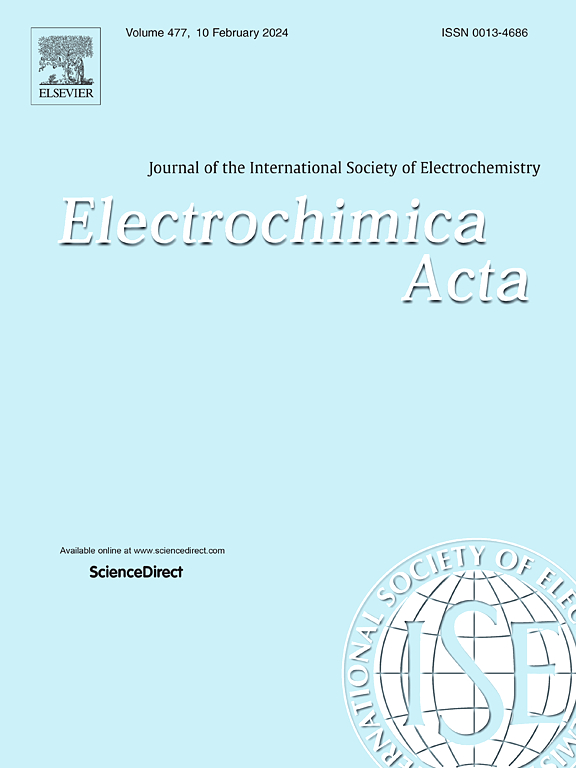通过废物生物质循环增值的电化学过氧化氢生成:污泥消化和植物质的残留物的协同处理
IF 5.6
3区 材料科学
Q1 ELECTROCHEMISTRY
引用次数: 0
摘要
作为厌氧消化的副产品,消化液的产量不断增加,需要可持续的增值策略,以避免垃圾填埋处理,并限制沼气工业的发展。本研究通过水热炭化(HTC)技术,探索了以污泥消化液和芦苇生物质为原料合成水合物及其1:1 (w/w)混合物(H1:1)的方法。此外,还对其进行了后续热解或KOH化学活化。主要目的是研究这些材料通过双电子氧还原反应(2e⁻ORR)在电化学生成H₂O₂中的电催化性能。所有合成的材料进行了全面的物理化学表征,包括终极和近似分析、N2吸附等温线、TGA、拉曼光谱、FTIR光谱和SEM,以将新型碳质材料的性质与其电催化性能联系起来。表征表明,H1:1样品具有一系列有趣的特性,包括稳定性、孔隙度、官能团的存在和结构缺陷。此外,在碳氢化合物后处理后观察到官能团的显著减少。使用线性扫描伏安法(LSV)的电化学分析显示,高电流密度和低H1:1的起始电位,与其较好的H₂O₂生产效率(2小时100 mg L -⁻)相关,超过热活化样品(64和36 mg L -⁻)。这是由于其协同成分、羧基官能团和结构缺陷促进了氧的吸附和活化。这些发现表明,通过具有成本效益和可扩展的HTC技术,可以将污泥消化转化为高性能阴极材料,从而实现可持续的H2O2生产。本文章由计算机程序翻译,如有差异,请以英文原文为准。

Electrochemical Hydrogen Peroxide Generation through Circular Valorization of Waste Biomass: Co-processing Sludge Digestate and Phytomass Residues
The increasing production of digestate, a byproduct of anaerobic digestion, requires sustainable valorization strategies for avoiding landfill disposal and constraints in the development of biogas industry. This study explores the synthesis of hydrochars derived from sludge digestate and Phragmites australis biomass, as well as their 1:1 (w/w) mixture (H1:1) via hydrothermal carbonization (HTC). Furthermore, their subsequent pyrolysis or chemical activation with KOH was also carried out. The primary goal was to investigate the electrocatalytic performance of these materials in the electrochemical H₂O₂ generation through the two-electron oxygen reduction reaction (2e⁻ORR). All the synthesized materials underwent comprehensive physicochemical characterization, including ultimate and proximate analysis, N2 adsorption isotherms, TGA, Raman spectroscopy, FTIR spectroscopy and SEM, in order to correlate the properties of novel carbonaceous materials with their electrocatalytic performance.
The characterization revealed that the H1:1 sample exhibits an interesting combination of properties, including stability, porosity, the presence of functional groups, and structural defects. Moreover, a significant reduction in functional groups was observed upon hydrochar posttreatments. Electrochemical analysis using linear sweep voltammetry (LSV) demonstrated high current density and a low onset potential for H1:1, correlating with its superior H₂O₂ production efficiency (100 mg L⁻¹ at 2 hours), surpassing thermally activated samples (64 and 36 mg L⁻¹). This performance was attributed to its synergistic composition, carboxylic functional groups, and structural defects, which promote oxygen adsorption and activation. These discoveries showcase the potential of transforming sludge digestate into high-performance cathode materials for sustainable H2O2 production through the cost-effective and scalable HTC technology.
求助全文
通过发布文献求助,成功后即可免费获取论文全文。
去求助
来源期刊

Electrochimica Acta
工程技术-电化学
CiteScore
11.30
自引率
6.10%
发文量
1634
审稿时长
41 days
期刊介绍:
Electrochimica Acta is an international journal. It is intended for the publication of both original work and reviews in the field of electrochemistry. Electrochemistry should be interpreted to mean any of the research fields covered by the Divisions of the International Society of Electrochemistry listed below, as well as emerging scientific domains covered by ISE New Topics Committee.
 求助内容:
求助内容: 应助结果提醒方式:
应助结果提醒方式:


